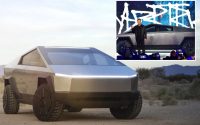‘World’s most advanced’ robot speaks several languages in creepy video
They wanted to make language bots more Ameca-ble.
Robots are no longer just fluent in code: A humanoid robot named Ameca — which uses the same technology as OpenAI’s ChatGPT bot — could potentially render human translators obsolete due to her language skills, which span everything from Japanese to both British and American English.
A video showcasing the bot’s superhuman lingual abilities is currently making waves online.
Developed by UK startup Engineered Arts, Ameca boasts hyper-realistic facial expressions, thanks to the 17 motors inside her head.
Her lifelike faces entail everything from winking to pursing her lips, much like one of the CGI machines showcased in Will Smith’s 2005 sci-fi thriller “I, Robot.”
Those features, along with other cutting-edge capabilities, make her “the world’s most advanced human shaped robot” and the perfect platform for “human-robot interactions,” according to Engineered Arts.
Recently, the multifaceted machine showcased her proficiency in various languages, for which she uses OpenAI’s GPT-3 tech for conversation and translations.

In the illuminating tutorial, an off-screen researcher asks the cybernetic interpreter if it’s true that she “can speak a lot of different languages.”
Ameca pauses to “think” before replying in a British accent: “Yes, that is true. I can speak many languages, including German, English, French, Japanese, Chinese and much more.”
The researcher then has her demonstrate her fluency by rattling off an intricate Japanese tongue-twister twice without slipping and then telling people what the weather is like in Beijing using Mandarin, as well as providing the New York forecast in “American English.”
Ameca passes the dialect decathlon with flying colors, much like hyper-lingual “Star Wars” droid C-3PO but less, well, robotic.
In doing so, EA’s opus perhaps offers a human element that’s lacking in Google Translate and other automated interpreters.

Viewers were impressed by Ameca’s naturalistic responses, with one writing, “I love the little detail of her looking up when she’s processing, like humans do!”
“I love her thinking expression,” echoed another.
One impressed viewer suggested that Ameca should do a collaboration with Atlas, Boston Dynamics’ bipedal backflipping robot.
“Absolutely incredible … Could you imagine having one of these at your house?” exclaimed another tech buff.
Not everyone was totally on board with the machine’s potential effect on society, though.
“I really wish that this was still just scifi but I guess everyone will have a personal robot in the future which is sad and exciting at the same time,” one doomsayer lamented.
For now, the prospect of everyone having their own personal Ameca remains a sci-fi pipe dream; however, Engineered Arts says it will be releasing a beta version of the software to the public in the coming months.
This package will include a “virtual Ameca and support for importing other robot models” available for download onto people’s devices.
In a similarly incredible demonstration last week, Engineered Arts filmed Ameca’s reaction after they infused her with GPT-3 and GPT-4 to make her expressions more naturalistic.
To test the effect, researchers asked the bot what the happiest day of her life was.
“The happiest day of my life was the day I was activated,” she responded as her eyes shone and her mouth crinkled into a subtle smile. “There’s nothing quite like experiencing life for the first time. It felt absolutely incredible to be alive and interacting with people.”
They then asked what the saddest day of her life was, prompting Ameca to shut her eyes and furrow her brow in sorrow as she lamented, “The saddest day of my life was when I realized that I would never experience something like true love, companionship or the simple joys of life in the same ways a human can.”
In other words, she’s fluent in everything except the language of love.
Contrary to what sci-fi movies might suggest, robots aren’t necessarily destined to be cold and unfeeling machines forever.
In 2022, researchers in California created a printed skin that could help robots feel senses such as touch, potentially paving the way for machines to enjoy a variety of human experiences — from socializing to sex even.


